Treadmills: A Comprehensive Guide to Understanding Their Functionality, Benefits, and Appropriate Selection
Introduction
Treadmills have become a staple in contemporary fitness regimens, both in homes and fitness centers worldwide. They use a convenient and effective method to keep cardiovascular health, boost endurance, and help in weight management. This post checks out the various kinds of treadmills, their benefits, functions to consider when acquiring, and some FAQs to assist users in making notified decisions.
Kinds of Treadmills
When it concerns selecting a treadmill, it is vital to understand the different types offered in the market. Here are the main classifications:
1. Handbook Treadmills
- System: These treadmills have an easy style and count on the user's efforts to move the belt.
- Pros: More inexpensive, quieter operation, no electrical power needed.
- Cons: Limited features, might not offer the same series of exercise intensity.
2. Motorized Treadmills
- Mechanism: Powered by a motor that drives the belt, permitting users to stroll or run at a set rate.
- Pros: Greater variety of speeds and inclines, equipped with many features such as heart rate monitors and workout programs.
- Cons: More pricey and may need more maintenance.
3. Folding Treadmills
- System: Designed for those with limited space, these treadmills can be folded for easy storage.
- Pros: Space-saving, frequently motorized, versatile features.
- Cons: May be less long lasting than non-folding designs.
4. Commercial Treadmills
- System: High-quality machines created for usage in gyms and gym.
- Pros: Built to hold up against heavy use, advanced functions, often include warranties.
- Cons: Pricey and not perfect for home usage due to size.
5. Curved Treadmills
- System: An unique style that enables users to move the belt using their own energy.
- Pros: Offers a more natural running experience, promotes much better running type.
- Cons: More expensive and can be noisier.
| Treadmill Type | Pros | Cons |
|---|---|---|
| Manual | Inexpensive, no electricity needed | Restricted features |
| Motorized | Range of speeds, advanced functions | Upkeep needed |
| Folding | Space-saving, frequently motorized | May lack toughness |
| Industrial | Built to last, professional-grade features | Costly |
| Curved | Natural running experience, promotes excellent form | Greater cost |
Advantages of Using Treadmills
Treadmills provide many benefits that can contribute to one's general fitness objectives. Some of these advantages include:
- Convenient Workouts: Treadmills permit users to work out inside no matter weather.
- Cardiovascular Health: Regular use can improve heart health by increasing endurance and promoting healthy circulation.
- Weight Management: Effective for burning calories, which assists in weight reduction and management.
- Customizable Workouts: Users can manage speed, incline, and period to create personalized workout experiences.
- Security: Treadmills provide a predictable surface area, reducing the danger of falls compared to outdoor running.
- Multifunctional: Many treadmills come with functions like heart rate monitors, workout programs, and even entertainment systems.
Choosing the Right Treadmill
When selecting a treadmill, potential purchasers must think about several essential factors:
Features to Consider:
- Motor Power: Typically determined in horse power (HP), a motor strength of a minimum of 2.5 HP is recommended for serious runners.
- Belt Size: A longer and larger belt accommodates numerous stride lengths, offering comfort throughout workouts.
- Slope Settings: Adjustable slope features replicate outside hill running and can increase workout strength.
- Weight Capacity: Ensure the treadmill can support the user's weight for security and longevity.
- Console Features: Look for user-friendly dashboards, workout programs, and Bluetooth compatibility for streaming music or other functions.
Budget Considerations
- Under ₤ 500: Entry-level manual treadmills ideal for casual walkers.
- ₤ 500 - ₤ 1,500: Mid-range motorized treadmills that provide more features and better durability.
- ₤ 1,500 - ₤ 3,000: High-end models with sophisticated innovation, bigger motors, and longer warranties.
- Over ₤ 3,000: Commercial-grade treadmills perfect for frequent usage in fitness centers or training facilities.
Frequently Asked Questions (FAQs)
1. How typically should I use a treadmill?
It is recommended to utilize a treadmill a minimum of three to five times a week, integrating different strength levels for best results.
2. Can I drop weight by utilizing a treadmill?
Yes, consistent use of a treadmill can contribute to weight reduction, specifically when combined with a well balanced diet plan and strength training.
3. What is the very best speed to walk on a treadmill for beginners?
A speed of 3 to 4 miles per hour is a suitable variety for beginners. It's necessary to begin sluggish and gradually increase speed as convenience and stamina enhance.
4. Do I require to use a treadmill if I currently run outdoors?
Utilizing a treadmill can provide extra advantages, such as regulated environments and differed workouts (slope, intervals) that are not always possible outdoors.
5. How do I maintain my treadmill?
Regular upkeep consists of lubricating the belt, cleaning up the deck and console, and inspecting the motor for optimal efficiency.
Treadmills are vital tools for those aiming to enhance their physical fitness levels in a regulated and hassle-free manner. With various types offered, understanding their features and advantages is important for making an informed purchase. By considering personal exercise needs, area schedule, and budget restrictions, people can discover the most suitable treadmill that fits their lifestyle. Incorporating gabriellaegner.top into a well balanced physical fitness regimen can cause enhanced health outcomes and a satisfying workout experience.

